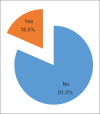Prevalence of nocturnal enuresis among children in Primary Health Care Centers of Family and Community Medicine, PSMMC, Riyadh City, KSA
- PMID: 30598936
- PMCID: PMC6259524
- DOI: 10.4103/jfmpc.jfmpc_32_18
Prevalence of nocturnal enuresis among children in Primary Health Care Centers of Family and Community Medicine, PSMMC, Riyadh City, KSA
Abstract
Background: Nocturnal enuresis (NE) is commonly known as any intermittent incontinence while asleep in a child being at least 5-year old. The families of the children having this disorder can be greatly worried because this disorder can lead to considerable emotional distress and some psychological consequences. This study is aimed to estimate the prevalence of NE among children and to identify the characteristics of children who has NE. The third aim is to identify the consultation pattern to solve this problem.
Methods: A cross-sectional survey was performed in Primary Health Care Centers of Family and Community Medicine, PSMMC, Riyadh City, KSA, during 2017.
Results: Out of 65 families that have children with NE, 38.7% was the frequency of bedwetting every night; 22.6% of the children were stressed as a result of new child birth; 14% of the families did not feel a family load of having children with NE; 29% of the families did not try to treat their children because of their improvement with time; and 12% of the families that tried to treat their children used fluid restriction and waked their children up frequently at night.
Conclusions: The prevalence of NE was 18.5% among families with a higher prevalence in boys. Prevalence of NE decreased with increasing age with many children found of having stressful events in their life other than parents' divorce. We would like to refer that it is important for families that have children with NE to seek medical consultation immediately, which can lead to behavioral modifications.
Keywords: Children; Saudi Arabia; families; familis; nocturnal enuresis; prevalence.
Conflict of interest statement
There are no conflicts of interest.
Figures
Similar articles
-
Prevalence of nocturnal enuresis among children and adults in Saudi Arabia: a systematic review and meta-analysis.Ann Saudi Med. 2024 Sep-Oct;44(5):349-359. doi: 10.5144/0256-4947.2024.349. Epub 2024 Oct 3. Ann Saudi Med. 2024. PMID: 39368117 Free PMC article.
-
Prevalence of nocturnal enuresis among children of Aseer region in Saudi Arabia.Urol Ann. 2024 Jan-Mar;16(1):81-86. doi: 10.4103/ua.ua_90_23. Epub 2024 Jan 25. Urol Ann. 2024. PMID: 38415232 Free PMC article.
-
Prevalence of nocturnal enuresis and its influence on quality of life in school-aged children.J Pediatr Urol. 2016 Jun;12(3):159.e1-6. doi: 10.1016/j.jpurol.2015.11.011. Epub 2015 Dec 24. J Pediatr Urol. 2016. PMID: 26778419
-
Prevalence of Nocturnal Enuresis among Saudi Children Population.Cureus. 2020 Jan 15;12(1):e6662. doi: 10.7759/cureus.6662. Cureus. 2020. PMID: 31966951 Free PMC article.
-
4. Bedwetting and toileting problems in children.Med J Aust. 2005 Feb 21;182(4):190-5. doi: 10.5694/j.1326-5377.2005.tb06653.x. Med J Aust. 2005. PMID: 15720177 Review.
Cited by
-
Sleep-Disordered Breathing and Its Association with Nocturnal Enuresis at the Primary Schools in Saudi Arabia: A Cross-Sectional Study.Children (Basel). 2023 Jun 18;10(6):1074. doi: 10.3390/children10061074. Children (Basel). 2023. PMID: 37371305 Free PMC article.
-
Prevalence of nocturnal enuresis among children and adults in Saudi Arabia: a systematic review and meta-analysis.Ann Saudi Med. 2024 Sep-Oct;44(5):349-359. doi: 10.5144/0256-4947.2024.349. Epub 2024 Oct 3. Ann Saudi Med. 2024. PMID: 39368117 Free PMC article.
-
Parental perception of nocturnal enuresis in a local region of Saudi Arabia.J Med Life. 2024 Jan;17(1):73-80. doi: 10.25122/jml-2023-0423. J Med Life. 2024. PMID: 38737650 Free PMC article.
-
Prevalence of Nocturnal Enuresis Among Children and Its Association With the Mental Health of Mothers in Northern Saudi Arabia.Cureus. 2022 Feb 15;14(2):e22232. doi: 10.7759/cureus.22232. eCollection 2022 Feb. Cureus. 2022. PMID: 35340510 Free PMC article.
-
Parental Beliefs About the Causes, Treatments, and Medical Assistance for Children With Nocturnal Enuresis in the Eastern Region of the Kingdom of Saudi Arabia.Cureus. 2023 Sep 2;15(9):e44557. doi: 10.7759/cureus.44557. eCollection 2023 Sep. Cureus. 2023. PMID: 37790064 Free PMC article.
References
-
- Neveus T, von Gontard A, Hoebeke P, Hjalmas K, Bauer S, Bower W, et al. The standardization of terminology of lower urinary tract function in children and adolescents: Report from the Standardisation Committee of the International Children's Continence Society. J Urol. 2006;176:314–24. - PubMed
-
- Tikkinen KA, Johnson TM, 2nd, Tammela TL, Sintonen H, Haukka J, Huhtala H, et al. Nocturia frequency, bother, and quality of life: How often is too often? A population-based study in Finland. Eur Urol. 2010;57:488–96. - PubMed
-
- Logan AC, Lesperance F. Primary nocturnal enuresis: Omega-3 fatty acids may be of therapeutic value. Med Hypotheses. 2005;64:1188–91. - PubMed
-
- Solanki AN, Desai SG. Prevalence and risk factors of nocturnal enuresis among school age children in rural areas. Int J Res Med Sci. 2014;2:202–5.
LinkOut - more resources
Full Text Sources
Medical



